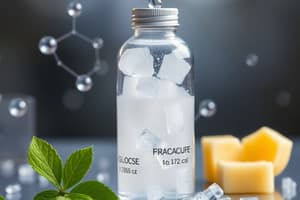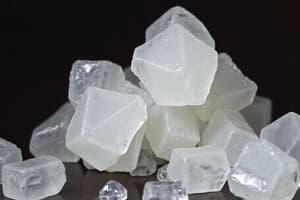Podcast
Questions and Answers
What is the main component of sucrose?
What is the main component of sucrose?
- Glucose and Maltose
- Fructose and Lactose
- Glucose and Fructose (correct)
- Glucose and Galactose
Which of the following statements is true regarding heterotrophs?
Which of the following statements is true regarding heterotrophs?
- They can synthesize their own sugars.
- They evolved to derive energy from plant-derived sugars. (correct)
- They primarily synthesize glucose.
- They rely solely on animal-derived sugars.
What role does fructose play in the body despite being present in low levels?
What role does fructose play in the body despite being present in low levels?
- It serves as the primary energy source for tissues.
- It is the main sugar stored in the liver.
- It acts as a signal of the ingested dietary sugar. (correct)
- It is converted primarily to starch.
How is sucrose digested in the body?
How is sucrose digested in the body?
What metabolic pathways are linked to fructose consumption?
What metabolic pathways are linked to fructose consumption?
What is a major consequence of high consumption of sugars in certain populations?
What is a major consequence of high consumption of sugars in certain populations?
Which compound primarily circulates in animals as an energy source?
Which compound primarily circulates in animals as an energy source?
Loss of ChREBP is associated with what type of dysfunction?
Loss of ChREBP is associated with what type of dysfunction?
What percentage of all caloric sweeteners did HFCS represent in the United States by 2000?
What percentage of all caloric sweeteners did HFCS represent in the United States by 2000?
Which of these foods is most likely to contain high-fructose corn syrup (HFCS)?
Which of these foods is most likely to contain high-fructose corn syrup (HFCS)?
What is the fructose content percentage of high-fructose corn syrup compared to table sugar?
What is the fructose content percentage of high-fructose corn syrup compared to table sugar?
According to the 2017-2018 NHANES data, what percentage of daily calories do Americans consume from added sugars?
According to the 2017-2018 NHANES data, what percentage of daily calories do Americans consume from added sugars?
What is a key feature of the ChREBPβ isoform?
What is a key feature of the ChREBPβ isoform?
What is the glycemic index comparison between agave and sucrose?
What is the glycemic index comparison between agave and sucrose?
How does condensed chromatin affect gene expression?
How does condensed chromatin affect gene expression?
What percentage of calories do Americans derive from ultra-processed foods according to a 2016 study?
What percentage of calories do Americans derive from ultra-processed foods according to a 2016 study?
What role does ChREBP play in metabolic syndrome?
What role does ChREBP play in metabolic syndrome?
Which receptors are activated by monosaccharides such as glucose and fructose?
Which receptors are activated by monosaccharides such as glucose and fructose?
What is the average daily caloric intake for an American adult based on 2017-2018 NHANES data?
What is the average daily caloric intake for an American adult based on 2017-2018 NHANES data?
What is known about the binding of ChREBP isoforms to ChoRE?
What is known about the binding of ChREBP isoforms to ChoRE?
What is the primary function of transcription factors in gene expression?
What is the primary function of transcription factors in gene expression?
What percentage of total liver lipids does de novo lipogenesis contribute in patients with non-alcoholic fatty liver disease?
What percentage of total liver lipids does de novo lipogenesis contribute in patients with non-alcoholic fatty liver disease?
What occurs in mice lacking ChREBP?
What occurs in mice lacking ChREBP?
Which component is involved in the transcription initiation complex?
Which component is involved in the transcription initiation complex?
What is the effect of ChREBP deficiency on lipogenesis?
What is the effect of ChREBP deficiency on lipogenesis?
How does ChREBP deficiency affect plasma glucose levels in mice?
How does ChREBP deficiency affect plasma glucose levels in mice?
In mice deficient in ChREBP, what happens to liver glycogen levels?
In mice deficient in ChREBP, what happens to liver glycogen levels?
What was the percent change in liver weight of ChREBP deficient mice compared to wild type on a high-starch diet?
What was the percent change in liver weight of ChREBP deficient mice compared to wild type on a high-starch diet?
Which parameter showed a significant increase in ChREBP deficient mice when given a standard rodent chow diet?
Which parameter showed a significant increase in ChREBP deficient mice when given a standard rodent chow diet?
What effect does ChREBP deficiency have on epididymal fat weight?
What effect does ChREBP deficiency have on epididymal fat weight?
How is plasma free fatty acid (FFA) concentration affected in ChREBP deficient mice?
How is plasma free fatty acid (FFA) concentration affected in ChREBP deficient mice?
What was the effect of ChREBP deficiency on pyruvate levels in the wild-type mouse liver on a high-starch diet?
What was the effect of ChREBP deficiency on pyruvate levels in the wild-type mouse liver on a high-starch diet?
Which parameter showed the largest increase in ChREBP−/− mice compared to wild-type on a standard diet?
Which parameter showed the largest increase in ChREBP−/− mice compared to wild-type on a standard diet?
How did the deficiency of ChREBP affect lipogenesis?
How did the deficiency of ChREBP affect lipogenesis?
What was a consequence of ChREBP deficiency in mice regarding metabolism?
What was a consequence of ChREBP deficiency in mice regarding metabolism?
In ChREBP−/− mice on a high-starch diet, how did PEP levels compare to wild-type mice?
In ChREBP−/− mice on a high-starch diet, how did PEP levels compare to wild-type mice?
Which metabolite is primarily responsible for the hypothermia observed in ChREBP−/− mice?
Which metabolite is primarily responsible for the hypothermia observed in ChREBP−/− mice?
Which experiment indicated the role of ChREBP in glycolysis?
Which experiment indicated the role of ChREBP in glycolysis?
Study Notes
Carbohydrate Contribution to the Carbon Cycle
- Animals are heterotrophs, meaning they can't make their own carbohydrates and depend on plants for their supply.
- Glucose is a primary fuel for most tissues in animals.
- Fructose represents a small portion of circulating sugar in animals.
- Fructose is rapidly processed by the intestines and liver, serving as a signal for dietary sugar intake.
- Sucrose, the main circulating sugar in plants, is composed of equal parts glucose and fructose.
- Fructose is converted for energy, transformed into glucose, or stored as a polymer (glycogen) or triglycerides.
Fructose Consumption and Health
- Fructose consumption has increased significantly in the United States, particularly due to the rising popularity of high-fructose corn syrup.
- High-fructose corn syrup represents a substantial portion of sweeteners used in the US food industry.
- Fructose is prevalent in many commercially processed foods.
- Fructose intake is linked to weight gain and metabolic diseases.
The Sweetness of Sugar
- Animals have evolved mechanisms to seek out and consume sugars, primarily through taste receptors.
- Sweetness triggers the release of neurotransmitters leading to a sense of pleasure and reward.
- This evolutionary adaptation is a response to fluctuating food availability to ensure energy storage during times of scarcity.
ChREBP Regulation of Metabolism
- ChREBP is a transcription factor that regulates glucose and fructose metabolism in the liver.
- ChREBP controls the expression of genes involved in glycolysis, lipogenesis, and other metabolic pathways.
- Two isoforms of ChREBP are known: ChREBPα and ChREBPβ.
- The presence of ChREBPβ might be regulated by ChREBPα.
- ChREBPα regulates the expression of genes like pyruvate kinase, contributing to glucose utilization and fat synthesis.
ChREBP Deficiency and Metabolic Dysfunction
- ChREBP deficiency in mice leads to impaired glucose tolerance, inability to metabolize fructose, and hypothermia.
- ChREBP deficiency in mice results in reduced lipogenesis and increased liver glycogen levels.
- ChREBP deficient mice exhibit lower body temperatures and eventually die due to their inability to metabolize fructose, underlining the importance of ChREBP in sugar metabolism.
Transcriptional Regulation
- Transcriptional activation in cells is dependent on chromatin state and the binding of transcription factors.
- Access to DNA for transcription depends on chromatin configuration.
- Open chromatin allows transcription factors to bind to promoter and enhancer regions, initiating gene expression.
- Condensed chromatin restricts access to DNA, inhibiting gene expression.
- Transcription factors can guide RNA polymerase II to target genes or work together with other proteins for gene transcription initiation.
Studying That Suits You
Use AI to generate personalized quizzes and flashcards to suit your learning preferences.
Related Documents
Description
This quiz explores the role of carbohydrates, specifically glucose and fructose, in the carbon cycle and their significance in animal physiology. It also discusses the implications of fructose consumption on health, particularly in relation to processed foods and high-fructose corn syrup. Test your knowledge on these essential concepts!




